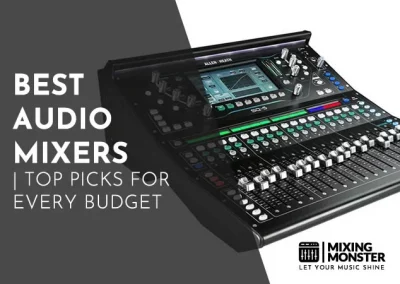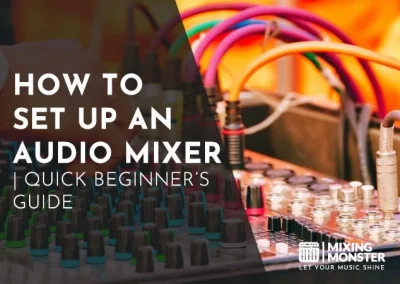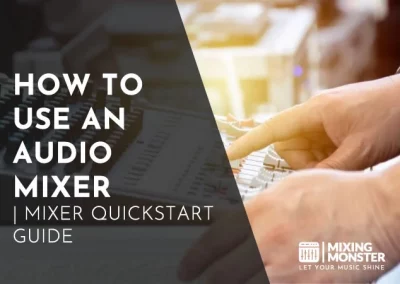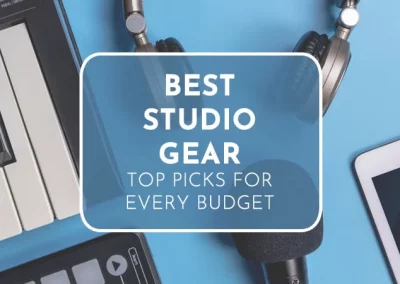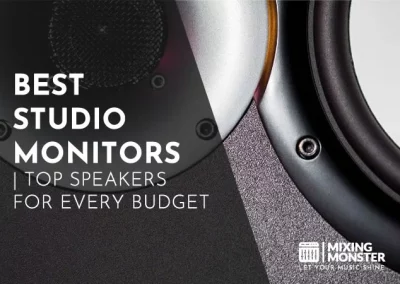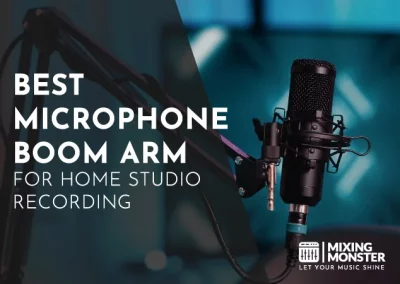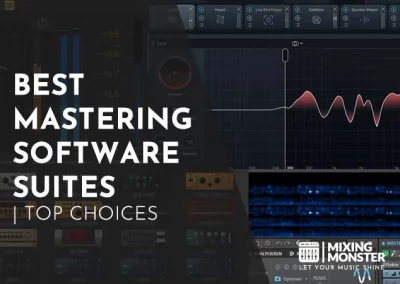Home > Blog > Studio Gear > Mixing Gear
Disclosure: Some of the links below are affiliate links, meaning that at no additional cost to you, we will receive a commission if you click through and make a purchase. Read our full affiliate disclosure here.
A sound PA system can make or break an event. Whether you’re hosting a live show, a speech, or a small gathering, having one of the best PA mixers provides you with reliable sound control and flexibility.
PA mixers—also known as public address mixers—sit at the heart of any audio setup. They allow you to blend microphones, instruments, and playback devices before sending the sound to the speakers. The best PA mixers offer a range of features, including multiple input channels, EQ, effects, and intuitive layouts that are easy to use without requiring a PhD to figure out.
When shopping for a PA mixer, consider the number of channels you need, the importance of portability, the build quality, the type of controls (digital versus analog), and the types of effects built in.
Your mixer should fit your event and use case, offer intuitive controls, and provide sufficient connectivity for your gear.
KEYNOTES:
- In this article, you’ll find a comprehensive list of the best PA mixers on the market.
- PA mixers are categorized into 3 sections:
Best Entry-Level PA Mixers
Best Professional PA Mixers
Best High-End PA Mixers - Each section contains:
3-5 PA Mixers
ordered by price (low > high) - In case you need a specific type of audio mixer, you might also be interested in:
Best Audio Mixers
Best Analog Mixers
Best Digital Mixers
Best Rack Mixers
Best Summing Mixers
Best DJ Mixers
Best Podcast Mixers
Best Gaming Mixers
Our Top Picks – Best PA Mixers
Best Entry-Level
Behringer
X32
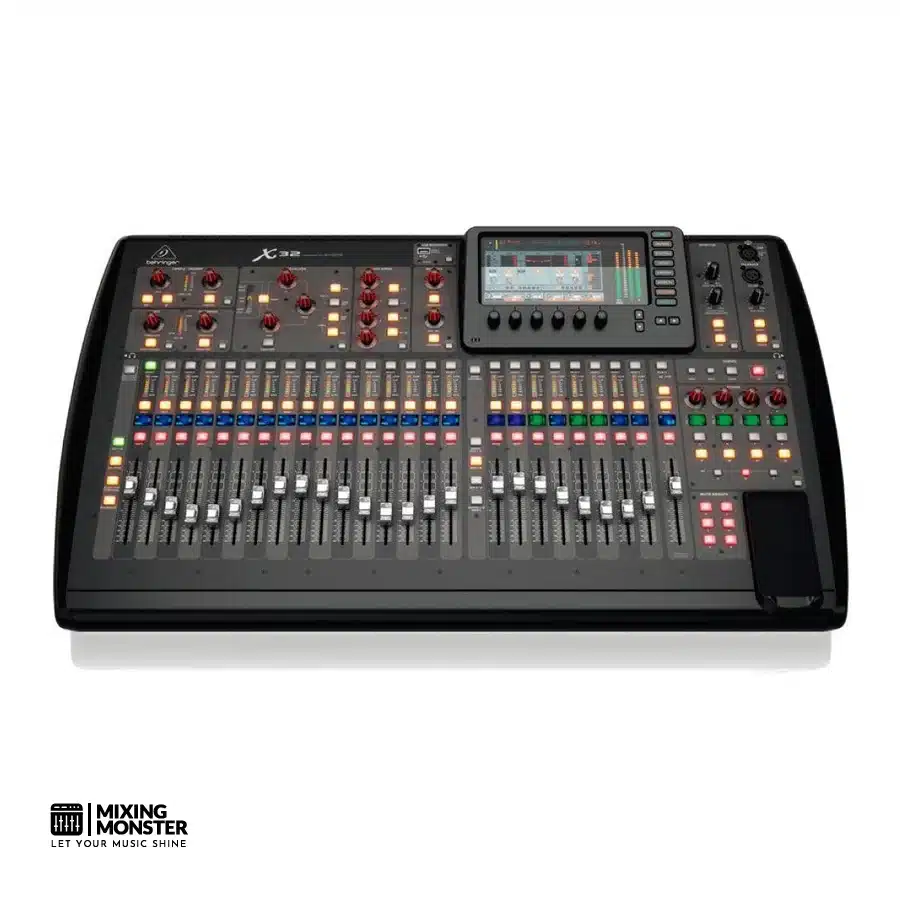
Best Professional
Midas
M32 Live
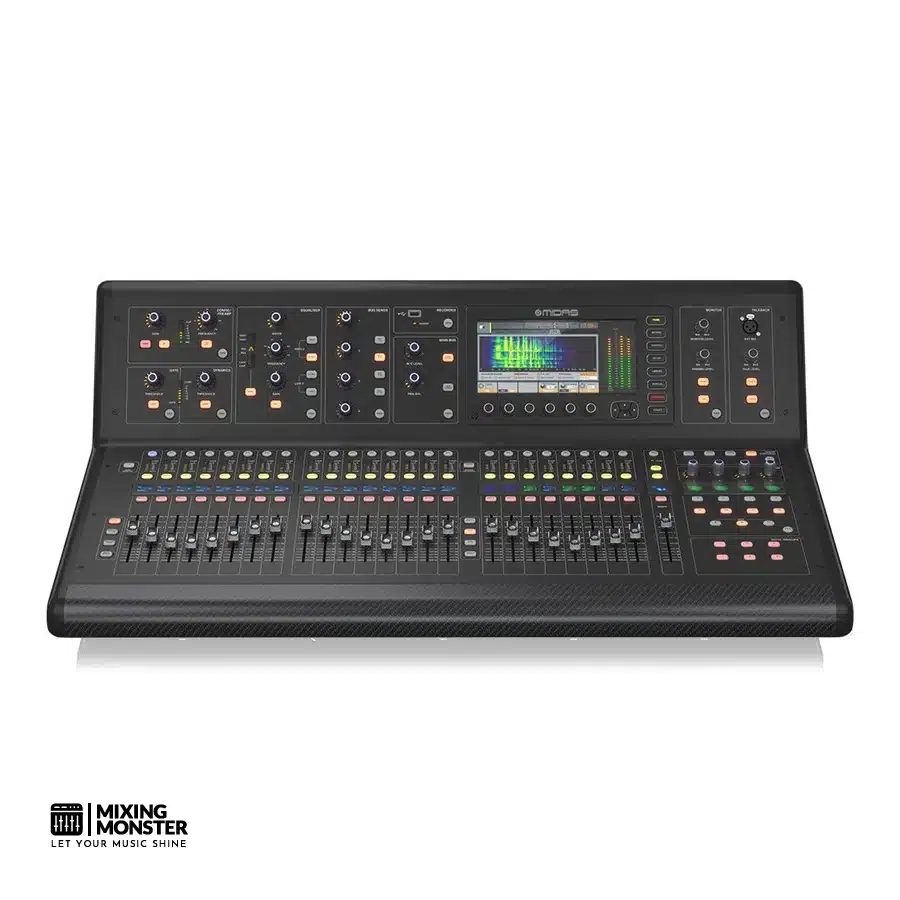
Best High-End
Allen & Heath
Avantis
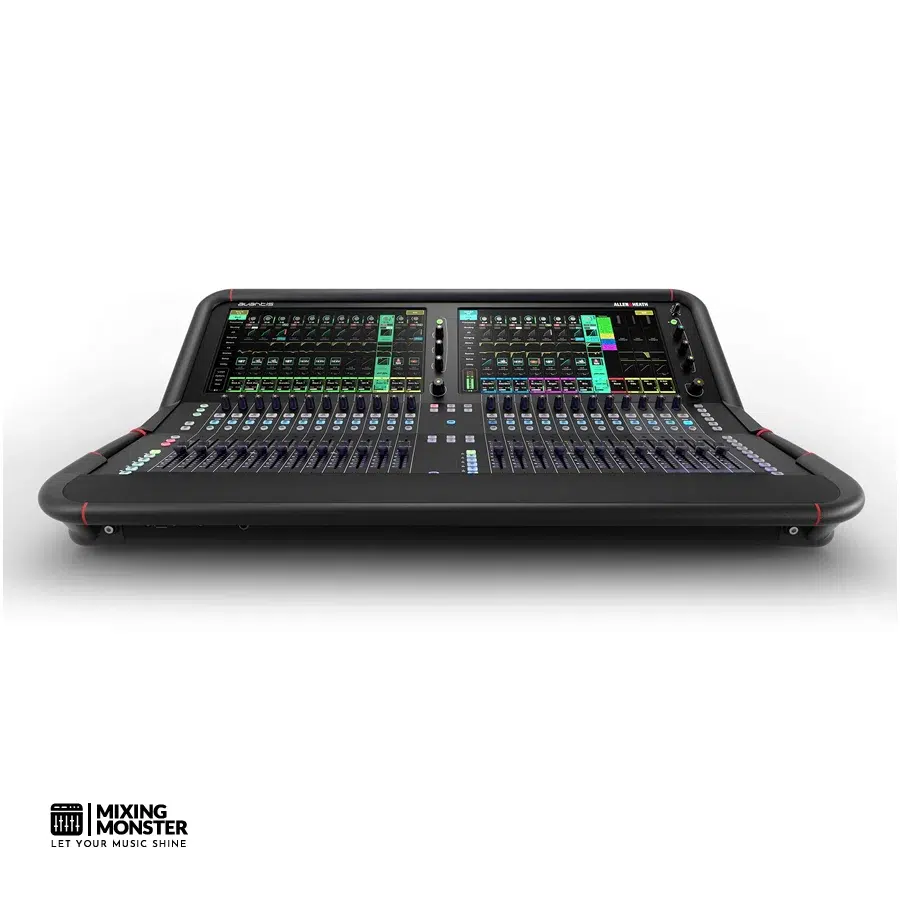
Table Of Contents
1. What Are The Best PA Mixers?
Best Entry-Level PA Mixers
Best Professional PA Mixers
Best High-End PA Mixers
2. What Is A PA Mixer?
3. Essential Accessories To Complement Your PA Mixer
4. PA Mixer Buying Guide
5. Finding Your Perfect PA Mixer: Key Takeaways
FAQ

1. What Are The Best PA Mixers?
We’ve dug into the top PA mixers available to help you find the right fit for your audio needs. There’s a range of features, brands, and price points available, so you’re likely to find something that suits your setup.
Here Are Our Picks For The Best PA Mixers:
Best Entry-Level PA Mixers
Best Professional PA Mixers
Best High-End PA Mixers
12. Allen & Heath Avantis
Best For Large Venues And Pro Audio Engineers

Best Entry-Level PA Mixers
#1 Yamaha DM3S
Best For Compact Live Sound, Flexible Studio Recording, And Quick Portable Setups
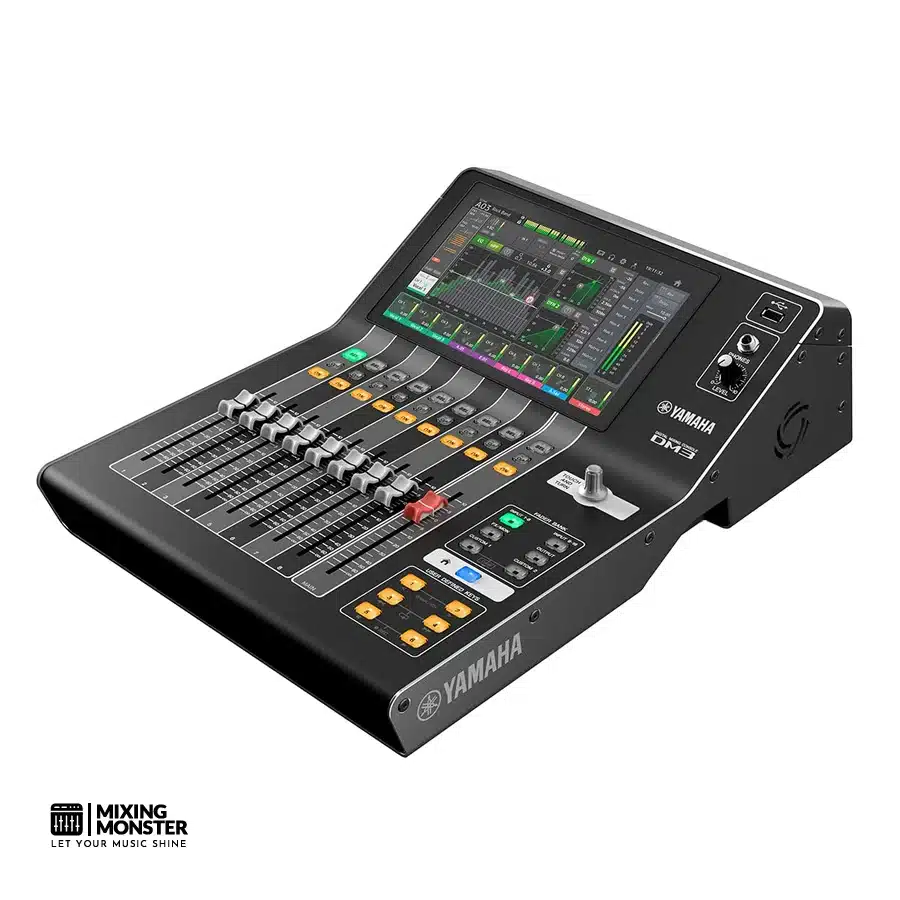
Overview:
The Yamaha DM3 Standard DM3S Compact Digital Mixer stands out for its compact design and professional-level sound. Yamaha built this mixer to support 96 kHz audio, and the interface feels intuitive, even when things get hectic.
When we tested it, we could carry it around easily—no worries about it feeling flimsy, either. It handled everything from live gigs to studio sessions with a steady hand. Yamaha’s attention to detail is evident.
Pros:
- Lightweight but sturdy enough for regular travel
- Setup is quick, with presets that make sense
- Clear, detailed audio at high sampling rates
Cons:
- You can’t expand much unless you go for Dante connectivity
- The touch display doesn’t love gloves or sweaty hands
- Price might be a stretch if you’re after just the basics
Unique Selling Point:
This DM3S mixer packs 96 kHz power and serious flexibility into a small, portable unit—great for compact PA or studio rigs.
Key Benefits:
- Fast setup with genre-based presets for both inputs and outputs—less guesswork, more music
- Multi-effect processors let you tweak sounds live; no extra gear is needed
- Remote control via dedicated apps—adjust things from anywhere in the venue or studio
Pricing:
| Average Price | ~ $1689 |
Review:
When we unboxed the Yamaha DM3, we noticed its sturdy build and surprisingly light feel. Carrying it to gigs or rehearsals was never a hassle—the kind of thing you toss in the car without a second thought.
Setup took barely any time, especially with the QuickPro Presets. We found a preset for nearly every instrument and mic we threw at it, which meant we could skip a lot of the usual soundcheck headaches.
The 9-inch multi-touch screen stood out. It made adjusting levels and routing easy, and after a couple of sessions, the interface felt second nature. We did encounter some issues with touch sensitivity when our hands were sweaty or gloved—conditions that are relatively common during load-in or outdoor shows—but overall, the workflow remained smooth.
We recorded directly into our DAW via USB, supporting up to 18 channels simultaneously. That was huge for rehearsals, we wanted to keep or live shows we wanted to track. Using the DM3 StageMix app, we could make monitor tweaks onstage in seconds, which saved us more than once.
The mixer didn’t sacrifice sound quality for portability. Our mixes stayed clear, even in bigger rooms. Having used numerous heavier analog and digital boards, we appreciated how this Yamaha strikes a balance between size and features.
The built-in effects weren’t just plentiful—they were suitable for vocals, drums, and more. Routing options were strong, although we wished Dante Networking would expand its digital setup. Still, for most purposes, it was more than enough.
#2 Presonus StudioLive 32SC
Best For Portable, Professional Live, And Studio Mixing In A Compact Format
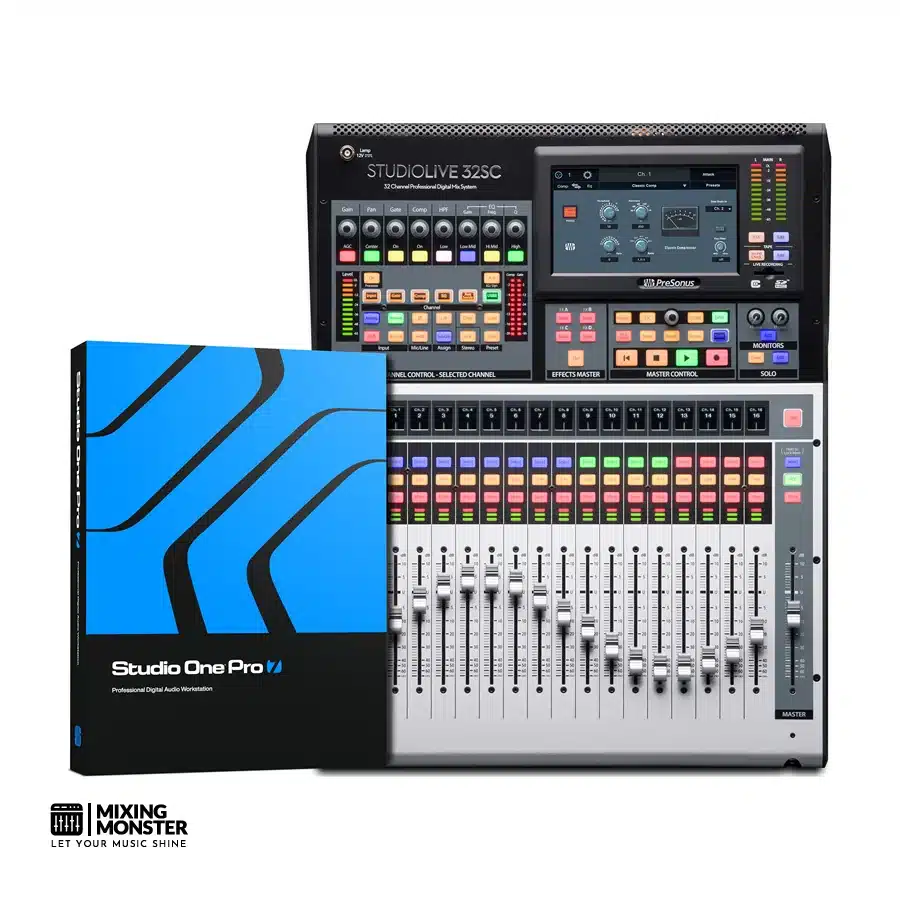
Overview:
The PreSonus StudioLive 32SC Compact Digital Mixer brings 32 channels of mixing to a portable, rack-mountable chassis. We found it offers a ton of mixing options without hogging space.
AVB networking, flexible routing, and a tight software ecosystem set the StudioLive 32SC apart from many other mixers we’ve tried. The processing power and PreSonus integration make this board a strong contender in the compact segment.
Pros:
- Serious DSP and routing options, especially for such a small unit
- Portable and rack-mountable—easy to lug around
- Works smoothly with other PreSonus gear for both stage and studio
Cons:
- It takes some time to learn if you’re new to digital mixers
- Networking can get finicky if you don’t use the correct hardware
- Registering for support isn’t always a breeze
Unique Selling Point:
The StudioLive 32SC delivers high-end DSP, flexible setup, and AVB networking in a compact frame—power typically found only in larger, pricier mixers.
Key Benefits:
- Mixing Flexibility: AVB networking and 16 FlexMixes enable you to handle a wide range of applications, from multi-zone venues to onstage monitoring.
- Onboard Recording and Virtual Soundcheck: You can record all inputs directly to SD or computer, making live sessions and virtual soundchecks much easier.
- Real-Time Control and Integration: The software integration allows you to control mixes, recall scenes, and adjust settings from your DAW or mobile device.
Pricing:
| Average Price | ~ $1689 |
Review:
We put the StudioLive 32SC through its paces in a few live settings and came away impressed with what it packs into a portable design. The motorized faders and Fat Channel processing on every channel made transitions during shows pretty painless.
Switching between studio and live setups felt natural, especially with AVB networking. Daisy-chaining stage boxes and monitor mixers was a breeze, which significantly reduced cable headaches.
Each FlexMix can serve as an aux, subgroup, or matrix mix, allowing you to get creative with your routing. Once you get past the initial learning curve, setting up multiple outputs in a busy environment is pretty straightforward.
PreSonus Capture and Studio One Artist software let us bounce from live recording to post-mix without wrestling with files. The sound quality was solid—the vintage-style EQs and compressors added warmth that typically only comes from larger studios.
The touchscreen and motorized faders felt responsive, but if you’re used to analog boards, expect a little adjustment period. For networking, we recommend using supported AVB switches and cables to avoid unexpected glitches.
Registering the mixer for support took longer than we’d like, so plan if you need help right away. All in all, the StudioLive 32SC has earned a spot in our portable rig. It strikes an outstanding balance of power, integration, and flexibility for anyone who wants a lot of control without hauling around a massive board.
#3 Behringer X32
Best For Versatile Digital Live Mixing With Extensive I/O And Remote Control

Overview:
The Behringer X32 Digital Mixer offers a flexible platform for controlling both live sound and studio settings. With 40 input channels and 25 mix buses, it’s ready for growth, whether you’re handling gigs or working in a house of worship.
Mixing feels smooth and intuitive, thanks to the 32 programmable MIDAS preamps and 25 motorized faders. Onboard effects and detailed connectivity mean you can handle complex audio routing without extra gear cluttering your space.
If you’re stepping into digital mixing or leaving analog behind, the X32’s blend of features and usability is hard to ignore.
Pros:
- Motorized faders make scene changes and detailed control easy
- Vast I/O and routing options fit small to mid-sized venues
- Remote control via iPad/iPhone streamlines setup and tweaks
Cons:
- There is a steep learning curve if you’re new to digital mixers
- Physical size and weight make frequent transport a hassle
- Digging through deep menus can slow you down at fast-paced events
Unique Selling Point:
The Behringer X32 stands out by combining a high channel count, motorized controls, and expandable digital networking—all at a price significantly below that of most professional digital consoles.
Key Benefits:
- Flexible Mixing Capability: With 40 input channels and robust bus architecture, you can manage complex live or studio mixes without running out of space.
- Remote App Control: The iPad/iPhone remote allows you to adjust levels while walking the venue, making sound checks effortless.
- Integrated Effects: The built-in FX rack and processing mean you won’t need external units, so your setup stays streamlined.
Pricing:
| Average Price | ~ $2239 |
Review:
Using the Behringer X32, we immediately noticed how the touch-sensitive, motorized faders saved time and effort recalling scenes during performances. Each fader assignment is visually labeled, making setup and troubleshooting significantly less stressful.
Adjusting mixes for both front-of-house and monitor engineers felt straightforward, with all bus routing right on the top panel. The X32’s connectivity is flexible, covering everything from local analog sources to advanced digital audio networking through its inputs, outputs, and expansion cards.
We loved having high-quality MIDAS preamps on board. Sound across all our microphones and instruments came through clean and transparent, which isn’t something you get with every board at this price.
Newcomers to digital consoles will face a learning curve; there is no way around it. Documentation and online tutorials are helpful, but hands-on time is what gets you comfortable. Changing audio routing and navigating the effects menus requires patience, especially when things move quickly.
Remote control of the Behringer X32 over Wi-Fi worked reliably during rehearsals and shows. Adjusting monitor mixes from anywhere in the room was a game-changer, saving time and avoiding mix-ups with performers on stage.
Best Professional PA Mixers
#4 Behringer WING
Best For Complex Live Sound & Studio Control Needs
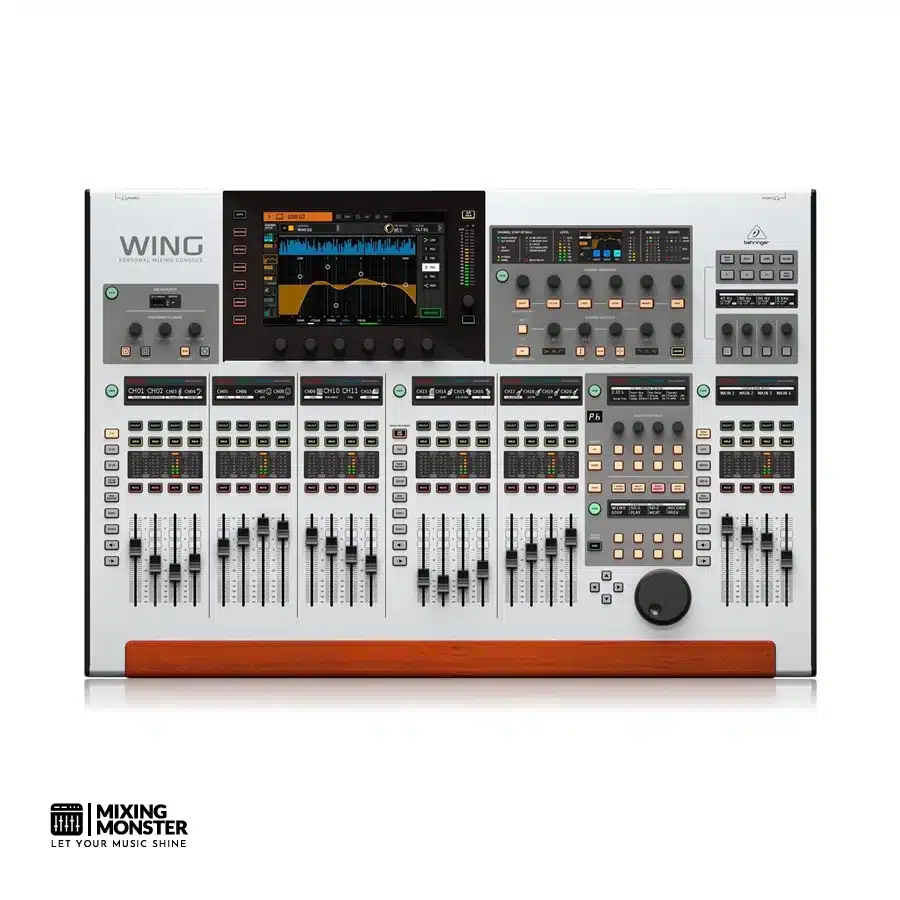
Overview:
The Behringer WING 48-channel Digital Mixer is built for advanced users and big, complex setups. Its touch-sensitive channel editing section stands out when you’re juggling a high channel count.
Integration with 48-in/48-out USB audio and onboard processing makes it a versatile tool for both live events and recording sessions. Professionals will find it powerful, but beginners might need extra time to get comfortable with the interface.
Pros:
- Deep channel customization and clear visual feedback help manage multi-source mixes
- Motorized faders and touch controls speed up the workflow
- Onboard effects and quality preamps produce detailed, clean sound
Cons:
- There is a steep learning curve, mainly if you’re used to simpler boards
- Large and heavy—tough to move and needs a lot of desk space
- Touchscreen issues pop up now and then, which can be annoying
Unique Selling Point:
The Behringer WING‘s touch-driven channel editing and high channel count let you handle anything from a full band to intricate studio sessions without bottlenecks.
Key Benefits:
- The touch interface makes editing and organizing channels straightforward, even during hectic shows.
- Numerous digital channels and USB integration streamline the recording process, eliminating the need for additional equipment.
- The onboard effects suite is comprehensive, so you rarely need external processors.
Pricing:
| Average Price | ~ $3499 |
Review:
When we used the Behringer WING, we realized it was a big leap from older models like the X32. Navigating with touch-sensitive controls, rotary knobs, and that color screen felt efficient, even when things got hectic.
The mixer handled complex inputs without breaking a sweat. Full-band live shows became easier to manage, and multitrack recordings had more spatial clarity than we expected.
The eight MIDAS Pro preamps provided us with a level of detail and headroom that made vocals and instruments truly shine. The interface’s tight integration with modern studio software also reduces setup time.
The setup isn’t exactly plug-and-play, though. The menu system can be daunting, and if you’re not familiar with digital boards, expect a steeper learning curve. Physically, it’s a beast—moving it around isn’t fun, and you’ll need a sturdy workspace.
Sometimes, the touchscreen of the Behringer WING doesn’t register commands or throws a “ghost touch.” It’s not the end of the world, but it can be frustrating, especially during a crucial performance or recording. We addressed this issue by keeping the firmware up to date and relying on physical controls when necessary.
#5 Yamaha TF-5
Best For Medium To Large Venues, Intuitive Digital Control
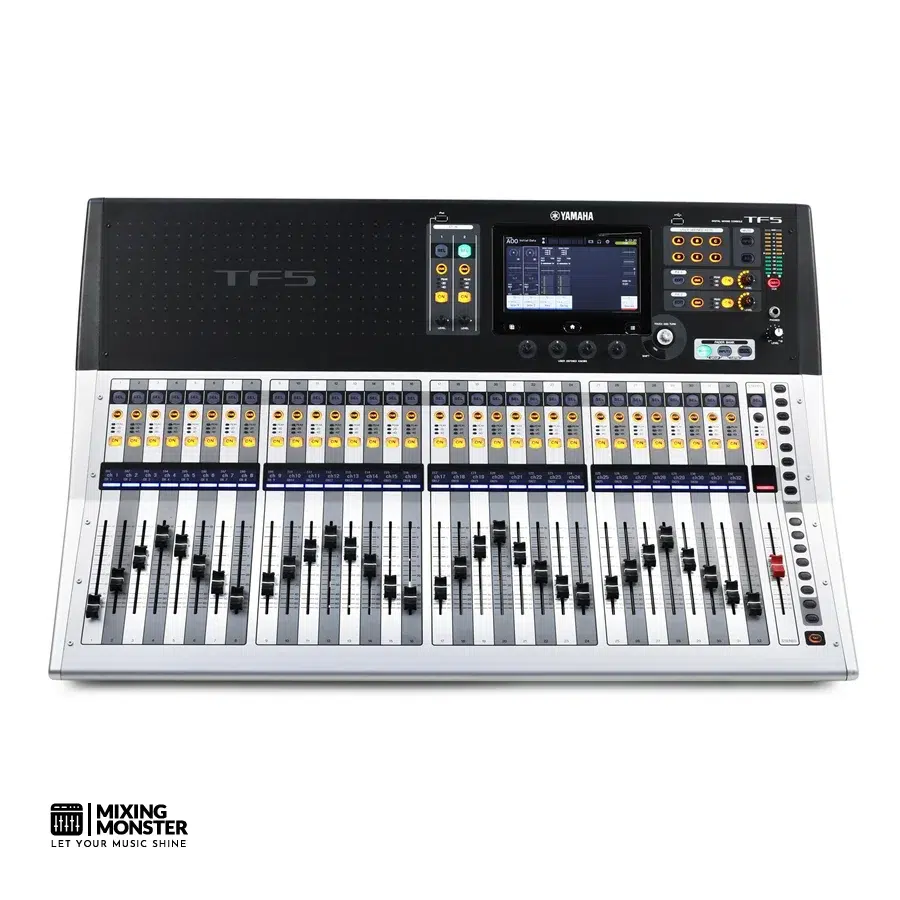
Overview:
The Yamaha TF5 32-Channel Digital Mixing Console combines versatility and practical usability in a way that stands out in live sound applications. After working with the TF5, it’s obvious Yamaha focused on streamlined workflows and creative freedom.
User navigation feels intuitive, and the motorized faders, along with the touch panel’s responsive interface, keep sessions moving quickly. You can tell the design aims to keep you focused on the sound rather than getting stuck in menus.
Pros:
- Quick setup and navigation with the intuitive touchscreen
- Robust input/output versatility for larger setups
- Reliable motorized faders make scene management smooth
Cons:
- Interface has a learning curve if you’re switching from older Yamaha models
- It’s heavy, so portability isn’t its strong suit
- Not exactly budget-friendly
Unique Selling Point:
The Yamaha TF5‘s streamlined touchscreen workflow enables you to make quick adjustments and get creative with mixing, even under pressure.
Key Benefits:
- Detailed channel management makes complex mixes easier, so you can adjust on the fly during performances.
- With numerous flexible inputs and outputs, you can handle any stage setup, from small bands to large ensembles.
- The sturdy build and motorized faders ensure it’ll withstand repeated use.
Pricing:
| Average Price | ~ $3499 |
Review:
When we set up the Yamaha TF5 for a live gig, the interface immediately stood out. The touch panel is responsive, and the menu system feels purpose-built for people used to digital mixers, but it’s not intimidating for newcomers either.
Navigating channels, routing, and effects is quick, which helps us stay focused on the actual sound. The motorized faders felt precise, and recalling saved scenes or setting up for different acts was smooth.
Scene memory and recall are straightforward, and having that physical fader movement gives confidence during fast changes. The sound quality lives up to Yamaha’s reputation: warm, detailed, and transparent.
Portability isn’t its strong suit, though. The weight is noticeable during load-in and load-out, so the TF5 works better as a permanent or semi-permanent fixture in venues or studios. If you’re accustomed to older Yamaha consoles, expect a slight adjustment to the updated interface.
After several gigs, the Yamaha TF5 proved reliable. We didn’t encounter any hiccups or glitches, even when running multiple inputs and outputs for extended periods. Yamaha’s build quality delivers, and its flexibility lets us use the TF5 for live sound, rehearsals, and even some basic recording.
#6 Midas M32 Live
Best For Large Channel Counts, Live And Studio Applications

Overview:
The Midas M32 Live Mixer stands out as a robust digital console built for both live performance and studio recording. We gained a significant amount of flexibility from its 40 input channels and 32 PRO preamps, which made managing complex setups feel significantly less intimidating.
The interface is intuitive, and the detailed onboard processing makes hands-on mixing a seamless experience. We found ourselves getting precise control without a headache.
Advanced networking and seamless SD card recording options enable you to adapt this device to various real-world scenarios. It doesn’t feel like it’s missing much.
Pros:
- Extremely flexible routing and input options
- Exceptional sound quality from PRO microphone preamps
- Straightforward integration with digital networks and multitracking
Cons:
- Heavier and bulkier than most similar digital mixers
- Interface learning curve for those new to digital consoles
- Price puts it out of reach for smaller budgets
Unique Selling Point:
The Midas M32 Live Mixer delivers professional-grade capabilities for both live sound stages and recording studios, featuring up to 40 input channels, award-winning microphone preamps, and versatile recording features.
Key Benefits:
- High channel count and extensive routing make it great for large bands or complex productions.
- Dual SD card recording and playback make live set capture and virtual soundchecks a breeze.
- Reliable Midas PREs keep input clean and dynamic for any source.
Pricing:
| Average Price | ~ $3499 |
Review:
When we tried out the Midas M32 Live Mixer, we immediately noticed how easily it scaled up for big events. The console gives you 40 simultaneous inputs, so you can mic up an entire band or a horn section and still have space for more.
Even with a packed stage, signal routing felt smooth and reliable. Using the PRO preamps made a clear difference—every vocal and instrument sounded open, full, and surprisingly free from noise.
The time-aligned mix buses maintained phase coherence when we sent groups to wedges and in-ears. Networking with the AES50 interface allows us to connect other digital gear and stage boxes, reducing long cable runs and making large venue setups more manageable.
Recording straight to SD cards saved us during live events and rehearsals—playback for virtual soundchecks was quick. We noticed that it saves a lot of time during sound checks.
The interface takes some getting used to, especially if you’re new to digital boards. But after a bit of practice, the M32 Live felt efficient and customizable, with a nice balance between touchscreen and physical controls.
It’s not the most portable mixer out there—the size and weight make it a better fit for installations, venues, or touring acts with a tech crew. If you need top-tier sound and flexibility, the Midas M32 Live Mixer delivers. In both noisy clubs and controlled studios, it has proven itself to be a solid investment for serious professionals.
#7 Allen & Heath QU-32C
Best For Versatile Live Sound Applications And Advanced Digital Mixing Control
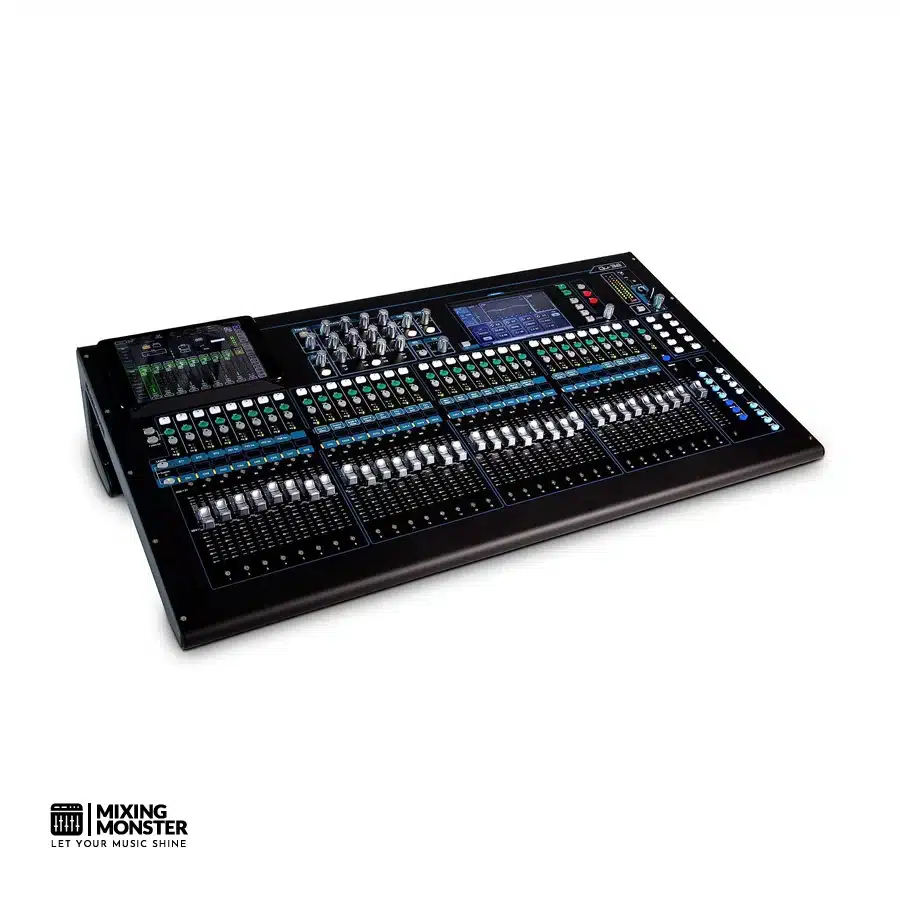
Overview:
The Allen & Heath QU-32C Compact Digital Mixer, Chrome Edition, strikes a nice balance between sophisticated digital performance and hands-on usability. With 33 motorized faders, recallable AnalogiQ preamps, and a bright touchscreen, it truly feels at home in professional settings.
We noticed that its workflow echoes that of higher-end Allen & Heath consoles, but it remains compact and approachable. The Chrome Edition features give us some extra confidence when mixing in unpredictable spots.
If you want reliable, high-quality audio and intuitive control, this mixer’s got you covered.
Pros:
- Fast, motorized fader recall saves time during set changes
- The Touchscreen interface is crisp and easy to navigate
- Flexible routing and powerful onboard effects simplify complex setups
Cons:
- Bulkier and heavier than other compact digital mixers
- Workflow may overwhelm users new to digital boards
- Firmware updates occasionally add steps to the setup
Unique Selling Point:
The Allen & Heath QU-32C Compact Digital Mixer stands out for its combination of motorized faders, accessible touchscreen, and recallable preamps, all refined through Allen & Heath’s experience with their high-end touring systems.
Key Benefits:
- Reliable, tactile control with 33 responsive faders, offering hands-on mixing for any source.
- High-visibility, multi-color touchscreen simplifies access to features, even in low-light conditions.
- Automatic mic mixing and integrated feedback detection tools let us focus on the mix instead of troubleshooting problems.
Pricing:
| Average Price | ~ $3799 |
Review:
Working with the Allen & Heath QU-32C felt like handling a professional-grade piece of equipment. The faders respond instantly, jumping to saved scenes, which is a massive advantage during multi-band shows or mid-event changes.
The touchscreen interface is smooth and responsive, enabling us to quickly adjust settings without having to navigate through endless menus. In tough venues, features like automatic mic mixing and visual feedback detection made our jobs much easier.
These tools genuinely cut down the time spent chasing feedback and built our confidence for live performances. Recalling entire show setups instantly is a huge convenience.
The setup is intuitive for those with experience in digital mixing, but it may feel overwhelming to newcomers. We relied heavily on the Qu-Pad wireless app, which freed us from the console and allowed us to resolve mix issues from anywhere in the room.
That flexibility is a big deal during live events. The only real gripe is the size and weight—if you’re loading in or out solo, expect a bit of a workout.
All the features help justify the footprint, but if you frequently move your gear, keep this in mind. Firmware updates sometimes add steps to setup, though Allen & Heath usually bring useful features with those updates.
After numerous studio sessions, we’re confident that the Allen & Heath QU-32C is a top-tier digital mixer for serious users. The tactile feel, deep features, and robust audio quality make it stand out for teams needing premium mixing performance.
#8 Allen & Heath SQ6
Best For Professional Live Sound Engineers Requiring Flexible, High-Capacity Digital Mixing
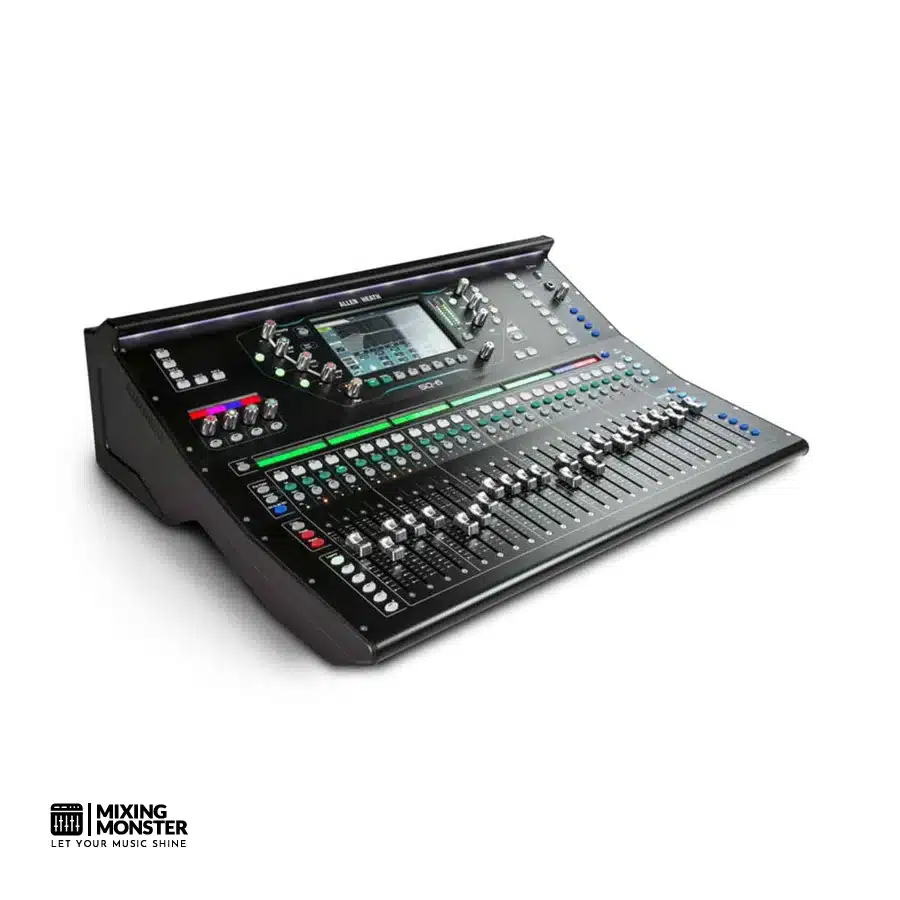
Overview:
The Allen & Heath SQ-6 Digital Mixer stands out as a robust digital solution for live sound professionals who need flexibility and reliability. It’s loaded with 48 input channels, 36 buses, and a 7-inch color touchscreen for easy navigation.
We found the 24 onboard preamps and 25 faders especially helpful during complex performances. Real-time adjustments are straightforward, thanks to the intuitive interface and all the routing options.
From medium venues to big productions, the SQ-6 covers a lot of ground and doesn’t flinch under pressure.
Pros:
- Powerful touch interface makes workflow fast and straightforward
- Audio routing flexibility simplifies complex setups
- Expandable with remote stage boxes and I/O card options
Cons:
- Steeper learning curve for users new to digital mixers
- Bulky and heavier than some competitors
- High prices may be out of range for smaller venues
Unique Selling Point:
The Allen & Heath SQ-6 Digital Mixer truly shines with its deep processing power, extensive I/O, and user-friendly touchscreen, providing a premium mixing experience in demanding live environments.
Key Benefits:
- Flexible Channel Management: 48 channels and 36 buses handle just about any setup you throw at it.
- Quick Configuration: The touch display and soft keys make it easy to access advanced features, saving setup time.
- Modular Expansion: Add digital protocols, such as Dante and Waves, to customize the system for any event.
Pricing:
| Average Price | ~ $4900 |
Review:
Setting up the Allen & Heath SQ-6, we quickly saw how easy it was to organize input and output assignments. The color touchscreen is responsive, and after a bit of practice, we could breeze through configuration changes during a sound check.
Storing and recalling show files proved helpful when working with multiple performers or rotating acts. Sound quality is what we expect from Allen & Heath—clean, transparent, and it holds up even with lots of channels running.
The routing options open up creative possibilities, especially when you hook up digital stageboxes or external audio networks via the I/O port. We’ve used it with various remote expansion options, and everything works seamlessly.
The learning curve is real—there’s a lot to explore. If you’re new to digital workflows, expect to spend some time getting accustomed to them. Once you get the basics, though, the workflow feels logical and fast.
It’s not the most portable mixer, so it’s best suited for permanent installations or events with sufficient setup time. The mixer felt right at home in both corporate events and concerts we handled.
Scene management and quick access to channel layers made fast-paced changes manageable. Fader banks and customizable soft keys let us tailor the workspace for each production.
After weeks of use, the Allen & Heath SQ-6 has stayed reliable and robust. In challenging live environments, it consistently delivers precise results and adapts easily to diverse needs. The investment stings a little, but the features and expandability make it worth it for pros who need serious mixing power.
Best High-End PA Mixers
#9 DiGiCo S31
Best For Fast Navigation For Live Sound Professionals
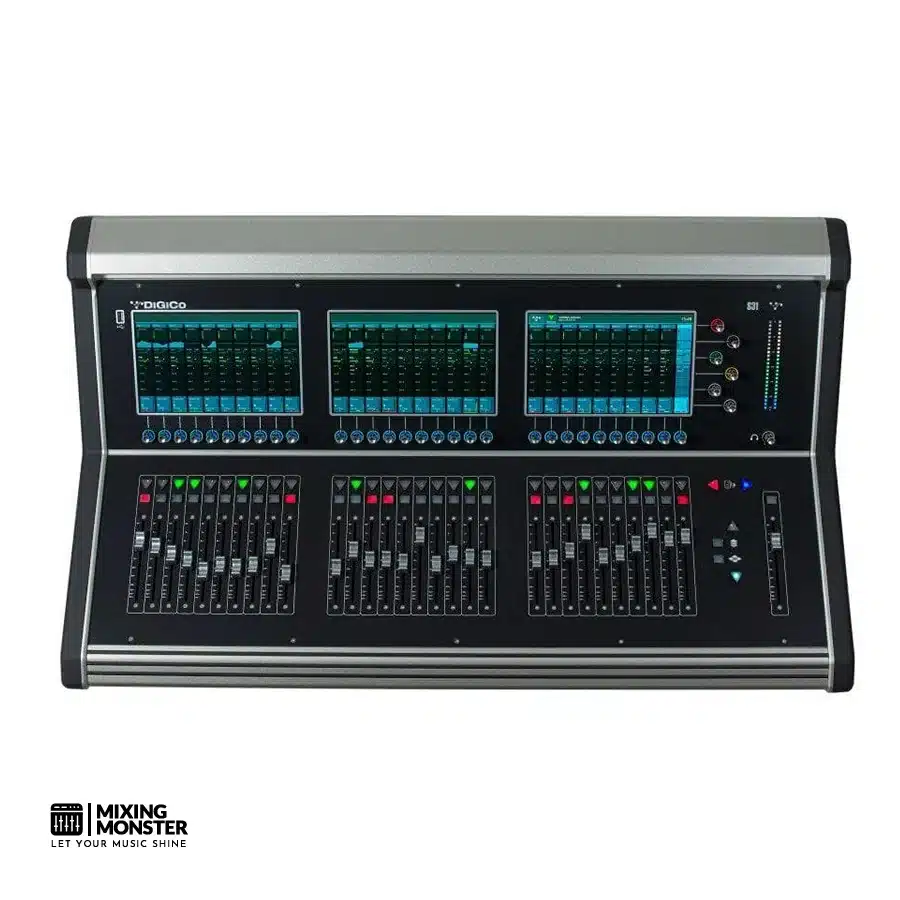
Overview:
The DiGiCo S31 is a digital mixing console that delivers clarity and efficiency. Its layout feels intuitive, and we can get around the controls without much fuss.
The touchscreen is quick and well-organized, letting us mix with precision. With 24 local inputs and 12 outputs, the S31 is well-suited for a wide range of live scenarios.
Pros:
- Clear, professional sound quality
- Logical, accessible control layout
- Fast operation despite touchscreen controls
- 48-channel multitrack USB recording
- Sufficient local I/O for small to mid-sized events
Cons:
- iPad app can respond slowly at times
- Official stage boxes are expensive
- Not as budget-friendly as some alternatives
Unique Selling Point:
The DiGiCo S31 stands out for its fast operation, intuitive interface, and generous onboard I/O. We often don’t need extra gear, which is a relief.
Key Benefits:
- Quick Workflow: We navigate, assign, and tweak channels fast—essential for live mixing.
- Comprehensive Recording: Direct 48-channel USB recording makes capturing shows simple.
- No Immediate Need for External Stageboxes: With 24-in/12-out, we can handle most projects using just the mixer.
Pricing:
| Average Price | ~ $9199 |
Review:
The DiGiCo S31 streamlines our workflow with its user-friendly design and responsive touchscreen. Even on complex gigs, the console remains accessible, allowing us to focus on the mix instead of fiddling with menus.
Sound quality meets professional standards and stays clear, even with high channel counts. The logical routing and channel structure help us set up and swap over quickly during live events.
USB multitrack recording is straightforward, allowing us to record shows for editing or direct output. The iPad app offers remote control, but it occasionally lags, particularly when the network connection is unstable.
Official stageboxes add up in cost, so expanding for bigger gigs needs careful budgeting. For our mid-scale events, though, the onboard I/O usually covers us.
The DiGiCo S31‘s speed, sound, and reliability make it a strong contender among digital PA mixers.
#10 Yamaha QL1
Best For Professional Compact Digital Mixing For Live And Studio Applications
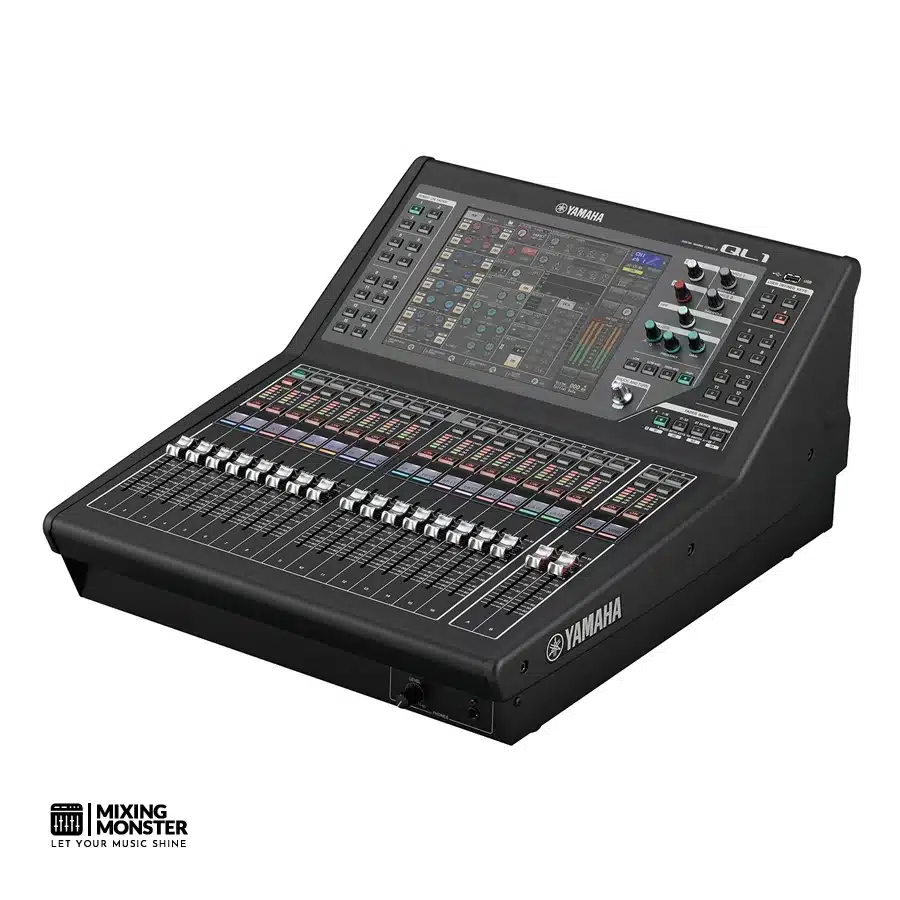
Overview:
The Yamaha QL1 is a digital mixing console aimed at medium-sized live events and studio work. Yamaha built it with intuitive controls and flexible connectivity in mind.
With 32 mono and eight stereo mix channels, the QL1 handles everything from concerts to corporate gigs. It’s versatile for its size.
Pros:
- Reliable and robust build quality
- Intuitive touchscreen interface
- Compact size with a powerful feature set
- Seamless Dante audio networking integration
Cons:
- The higher price point for its class
- Dust cover not included as standard
- Limited availability in some regions
Unique Selling Point:
The Yamaha QL1 blends full-featured digital mixing with a small footprint. It’s ideal for spaces and events that require both mobility and performance.
Key Benefits:
- Ease of Use: The interface is clear and organized, allowing us to navigate quickly—whether we’re new or seasoned engineers.
- Flexible Connectivity: Built-in Dante support enables seamless integration with various audio networks.
- Consistent Sound Quality: The audio processing is transparent and precise, yielding professional results with minimal coloration.
Pricing:
| Average Price | ~ $11190 |
Review:
We’ve used the Yamaha QL1 for everything from orchestras to corporate events. The solid chassis and precise controls are immediately noticeable.
Setup is easy thanks to the physical controls paired with a responsive touchscreen. The QL1’s compact size is perfect for tight spaces, but it doesn’t feel short on features.
Channels are easy to route, and we like customizing fader banks for different workflows. Dante integration makes network setups effortless, enabling us to adapt quickly and efficiently.
Audio quality is clean and accurate, which we value for acoustic performances. The preamps sound neutral and handle various inputs without adding noise.
The onboard processing tools are handy and easy to access—no need for endless menu diving. It’d be nice if the QL1 came with a dust cover, especially for outdoor gigs.
Finding one in stock can be challenging at times, particularly during busy touring seasons. Still, the Yamaha QL1 remains a solid pick for its reliability and ease of use in pro sound settings.
#11 Soundcraft VI1
Best For Versatile, User-Friendly Digital Mixing For Large Live Events
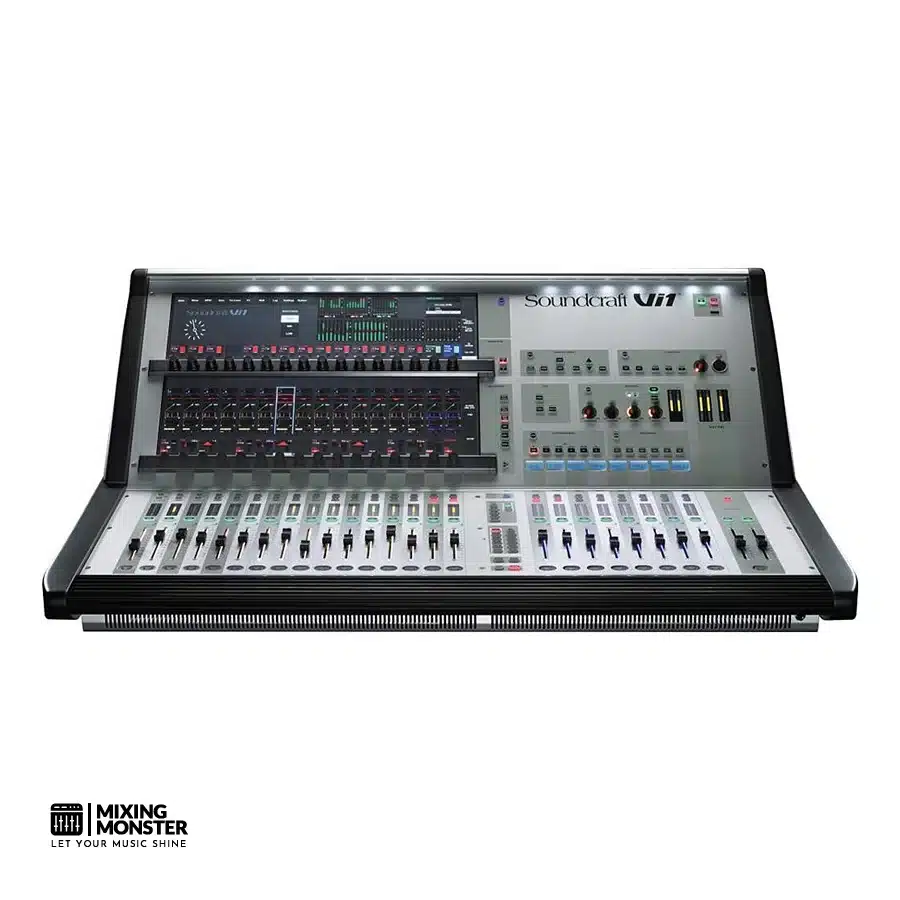
Overview:
The Soundcraft VI1 digital mixer is a compact but powerful choice for live sound. Its flexible interface and steady performance work well in venues where space and speed matter.
The touchscreen operation and streamlined controls let us work efficiently. The mixer integrates easily into most PA setups, and Soundcraft’s focus on audio fidelity is clear.
Pros:
- Intuitive touchscreen interface
- High-quality built-in effects
- Compact footprint
- Reliable preamps
- Flexible I/O options
Cons:
- Limited fader count compared to larger models
- Some menus can require extra navigation
- Firmware updates can be infrequent
Unique Selling Point:
The Soundcraft VI1‘s touch-driven, user-friendly workflow and compact design make setup and operation quick, especially when space is limited on stage.
Key Benefits:
- Fast Setup: The layout and touch controls help us get going quickly, saving time during sound checks.
- Space Efficiency: The compact chassis fits into tight front-of-house (FOH) spots while still offering the necessary features.
- Solid Sound Quality: High-grade preamps and DSP effects deliver clean, consistent audio for both speech and music, ensuring a superior listening experience.
Pricing:
| Average Price | ~ $12490 |
Review:
We’ve found the Soundcraft VI1 to be practical when space and speed are priorities. The touch screen makes things like EQ tweaks and routing changes fast and easy.
The board maintains depth without overwhelming us with menus or excessive controls. In live settings, its compact size is a real advantage, making transport and setup in small venues a breeze.
Sound quality holds up—preamps give us clarity and headroom, and the effects sound polished. Sometimes, digging into advanced menus takes a bit longer, but the learning curve is gentle.
I/O flexibility enables us to integrate with various PA systems easily. Firmware updates don’t come as often as we’d like, which might bother those chasing new features.
However, Soundcraft’s reliability and audio quality have consistently met our expectations. When we need a reliable mixer that sounds good and doesn’t slow us down, the Soundcraft VI1 is a go-to.
#12 Allen & Heath Avantis
Best For Large Venues And Pro Audio Engineers

Overview:
The Allen & Heath Avantis 64-channel, 42-bus, 96 kHz digital mixer feels like a modern workhorse for professional audio mixing. It brings flexible routing, deep onboard processing, and a solid, road-ready build.
Front-of-house and monitor engineers can both shape it to their needs. Customization and expansion options allow you to use it for touring, live events, or permanent installations.
Allen & Heath’s 96 kHz FPGA engine delivers clear, detailed audio to the Avantis. You can tell it’s built for demanding environments and serious users.
Pros:
- Dual touchscreens provide intuitive control and streamline workflow.
- There is plenty of onboard processing, so you don’t need much external gear.
- Routing and expansion options are as flexible as they get.
Cons:
- It’s heavy and big—not the most portable desk.
- Advanced features might take time to learn if you’re new.
- The price is high—a pro-level investment.
Unique Selling Point:
What sets the Avantis apart? Those dual, high-res touchscreens and the smooth integration of advanced digital processing. It’s designed for fast and efficient professional audio work.
Key Benefits:
- Dual touchscreens enable us to navigate through complex mixes quickly—navigation is a breeze.
- Expansion options, such as the Avantis dPack, unlock advanced processing and effects when you need them.
- The chassis can withstand a beating—ours has survived numerous setups and tear-downs.
Pricing:
| Average Price | ~ $15999 |
Review:
We used the Allen & Heath Avantis at a live event and came away impressed. The setup was straightforward—routing channels and dialing in monitor mixes didn’t slow us down.
The dual touchscreens made control easy, even when things got hectic and we needed quick recall. Processing power onboard is no joke. Compressors, EQs, and effects are readily available, so we rarely need to reach for external units.
The track upgrade added even more options, which let our workflow evolve as gigs changed. Durability also stood out—the console handled repeated load-ins without issue.
It’s worth noting the mixer’s weight and size. You’ll want plenty of space, so for smaller gigs, something lighter might make more sense.
Navigating all the features takes some practice. If you’re familiar with Allen & Heath, it’ll feel familiar, but newcomers should expect a learning curve. The remote control and expansion options shine for big productions.
#13 Yamaha DM7
Best For High-End Versatile Digital Mixing In Any Live And Studio Environments
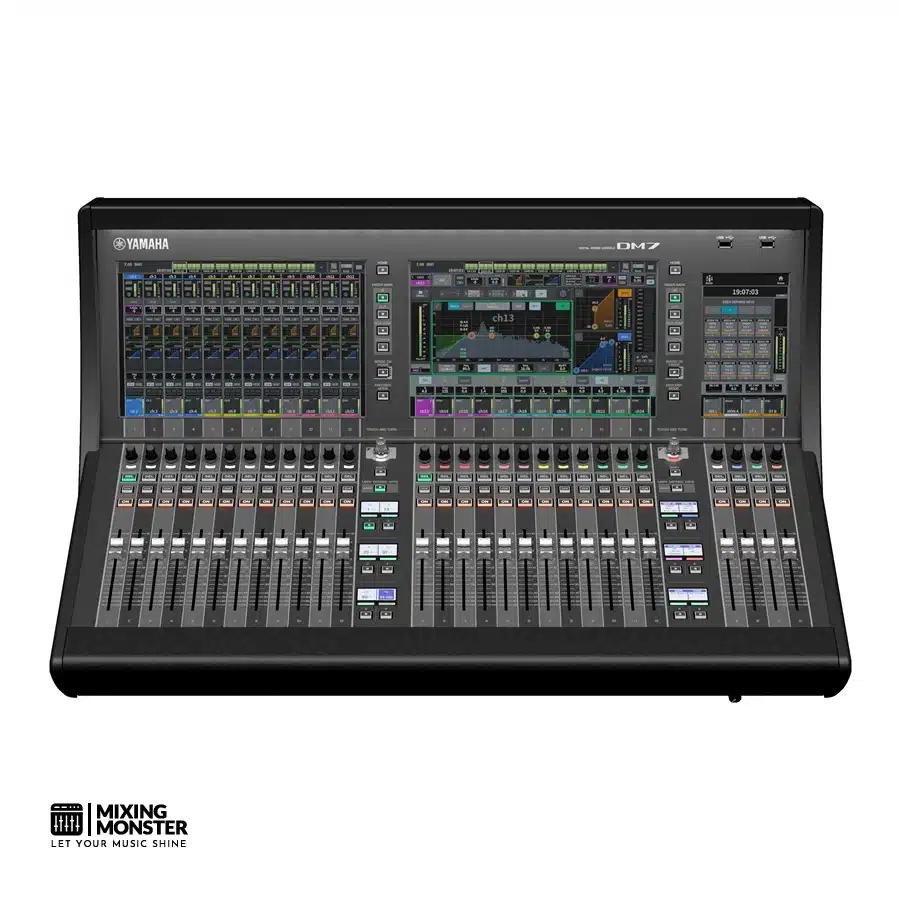
Overview:
The Yamaha DM7 is a pro digital mixing console built for flexibility and performance. In Yamaha’s DM Series, the DM7 stands out for its intuitive controls and advanced processing.
We found the layout and software integration to be effective for both live and studio gigs. Clear labeling and touchscreen navigation keep things moving during busy shows.
Pros:
- The touchscreen makes navigation simple.
- There are lots of routing options.
- Built-in effects and processing.
- Handles plenty of inputs and outputs.
- Automation features are flexible.
Cons:
- Beginners need some time to learn it.
- Bigger than some other mixers.
- It costs more than entry-level boards.
Unique Selling Point:
The Yamaha DM7‘s hybrid surface—featuring both touch and physical controls—enables you to quickly explore complex features without feeling overwhelmed.
Key Benefits:
- Comprehensive I/O enables us to connect a wide range of sources and outputs. It adapts to whatever we throw at it.
- Integrated processing enables us to utilize effects and EQ without requiring additional gear.
- Hybrid controls and customizable layers streamline setup and adjustments during a show.
Pricing:
| Average Price | ~ $25590 |
Review:
When we got our hands on the Yamaha DM7, the touchscreen and tactile controls immediately stood out. The workflow felt natural, and after the first setup, we barely glanced at the manual.
Assigning channels and building mixes was quick, even during rushed sound checks. The built-in effects and dynamic processing strike a balance between quality and flexibility.
Applying compression, EQ, or reverb was fast—no need for external gear. That cut down our setup time and let us tweak things mid-show without breaking a sweat.
Routing flexibility enabled us to switch seamlessly between concerts, conferences, and studio sessions. Saving and recalling different setups worked well, and the remote control let us listen from anywhere in the venue.
Sure, the DM7 is a bit bigger than some mixers, but the extra faders and controls made detailed jobs easier. Beginners may need more time to become comfortable, but Yamaha’s training resources can provide valuable assistance.

2. What Is A PA Mixer?
A PA mixer enables us to combine and control multiple audio signals for live sound. We use it to adjust sound quality, volume, and balance for mics, instruments, and other sources in a PA system.
PA mixers are available in two primary types: analog and digital. Analog mixers utilize physical knobs and sliders, whereas digital mixers ones rely on screens and software for additional features.
Key functions of a PA mixer include:
- Raising or lowering input levels
- Mixing multiple audio sources
- Shaping tone (EQ)
- Routing audio to speakers and monitors
We use PA mixers at concerts, conferences, houses of worship, and public events. Their real strength lies in handling numerous inputs and outputs simultaneously.
| Term | Description |
|---|---|
| Channel | Individual audio input |
| EQ | Equalization to adjust frequencies |
| Aux Send | Separate mix to monitors/effects |
| Fader | Slider to control volume |
Even in small rooms, a basic PA mixer helps us maintain a clear and balanced sound. Selecting the right mixer allows us to adapt to various needs and spaces.
3. Essential Accessories To Complement Your PA Mixer
When we set up a PA system, having the right accessories is just as important as the mixer. These extras help us achieve better sound, reliable connections, and a more straightforward setup.
We always need high-quality XLR and quarter-inch cables to connect microphones, instruments, and speakers. Using high-quality cables helps reduce noise and interference.
A mix of microphones gives us more options. We prefer dynamic microphones for vocals and condenser microphones for instruments.
Direct Boxes (DI):
DI boxes convert instrument signals into balanced signals, providing cleaner audio through the mixer.
Stands and Racks:
Solid stands and racks make gear easier to reach and keep things tidy. Adjustable stands help us make changes quickly during a show.
Cases and Covers:
We always protect our mixer when moving it around. Padded cases or covers help prevent bumps and dust from causing problems.
Power conditioners help us avoid surges and electrical noise. They keep our gear safe and running smoothly.
Here’s a table with a quick summary:
| Accessory | Primary Purpose |
|---|---|
| XLR Cables | Connect mics/instruments |
| Microphone | Capture sound sources |
| DI Box | Balance instrument signals |
| Mixer Stand | Secure, ergonomical setup |
| Power Conditioner | Stable, clean power |
| Mixer Case | Transport and storage safety |
The right accessories help us get the most out of our PA mixer—at any event, in any space.

4. PA Mixer Buying Guide
When selecting a PA mixer, we need to consider the number of channels we’ll require. A small band or a speaking gig? You might get away with just a few, but larger groups require more input options.
The kind of mixer you choose makes a difference, too. Analog mixers offer simple, hands-on control, while digital mixers incorporate features such as built-in effects and allow for remote control.
Let’s zoom in on some features that change how easy these things are to use—and how good they can sound:
| Feature | Why It Matters |
|---|---|
| Inputs/Outputs | Lets you hook up more mics and instruments |
| EQ Options | Helps you shape your sound |
| Onboard Effects | Adds reverb, delay, and other touches |
| Portability | Makes it way easier to move and set up |
| Routing Options | Gives you flexibility for tricky setups |
If you’re bouncing between venues, portability becomes increasingly essential. Smaller, lighter mixers are just less of a pain to haul around and set up.
Don’t ignore build quality, either. Mixers made with tough materials and solid construction last longer, mainly if you’re gigging frequently.
Connectivity is another thing to check. A mix of XLR, 1/4-inch, and maybe even USB ports can make your life a lot easier.
Before you buy, determine your primary use—live music, conferences, or recording. That way, you can focus on features that truly matter for your setup.
5. Finding Your Perfect PA Mixer: Key Takeaways
First, figure out your must-haves—how many channels, what kinds of inputs, and how much output flexibility you’ll use. This keeps you from getting lost in a sea of options.
Digital mixers offer more control and built-in effects, while analog mixers maintain a hands-on and straightforward approach. Consider which workflow feels right for you.
Here’s a quick comparison:
| Feature | Digital Mixer | Analog Mixer |
|---|---|---|
| Effects | Lots built in | Usually limited or none |
| Ease of Use | More to learn | Pretty straightforward |
| Price Range | All over the map | Often a bit cheaper |
If you plan to move the mixer frequently, consider prioritizing build quality and portability. Compact mixers with sturdy frames and handles make gig life easier.
Monitor routing and onboard EQ can save you a ton of time and headaches at shows. Double-check that your mixer is compatible with your other equipment, such as speakers and wireless microphones.
Let your budget steer you, but don’t go so cheap you miss out on what you need. Pick the essentials first, and you’ll end up with a mixer that works now and can grow with you.
Our Top Picks For The Best PA Mixers

FAQ
1) What Are The Key Features To Look For In The Best PA Mixers
We want plenty of input channels, quality preamps, and decent EQ controls. Onboard effects, built-in feedback suppression, and flexible routing all make your life easier. A rugged build and a layout that makes sense? That’s huge, too.
2) How Do I Choose The Right PA Mixer For My Live Venue?
Check the room size and sound quality before settling on the channel count and outputs. Smaller spaces may be suitable for a basic analog mixer, but larger venues typically require digital mixers with scene recall and remote control capabilities. Always think about future expansion—you’ll thank yourself later.
3) Are Digital Or Analog PA Mixers Better For Live Events?
Digital mixers bring you more features—think built-in effects, auto feedback control, and wireless apps. Analog mixers are renowned for their reliability and ease of use, particularly in smaller settings. Your best bet depends on what features you need, your budget, and what you’re comfortable with.
4) What Is The Easiest Way To Set Up A PA Mixer For A Live Show?
Label your channels, plug everything in, then power up. Set your gains, dial in the EQ, and run a quick sound check. If you’re using a digital mixer, presets can help you get set up fast.
5) Can PA Mixers Improve Sound Quality In Small Venues?
A decent PA mixer allows you to balance instruments, shape your sound with EQ, and reduce noise or feedback. Even in tiny rooms, having absolute control over your mix makes a noticeable difference for everyone listening.
6) How Much Should I Expect To Spend On A Top PA Mixer?
Prices vary significantly depending on the brand and the features you want. If you’re looking for a reliable mixer with enough channels and some decent effects, you can expect to spend between $500 and $4,500. You can find cheaper mixers out there, but they often skimp on professional features or lack multiple connection options for your gear.


